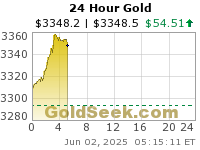I have mostly completed my programming of gold's four hour cycle and can begin to show you what I have come up.
This second screen shot is just a closer look at our current weekly cycle. You will notice that within the past couple of daily cycles (plum arrows) there were 3 four hour cycles (blue arrows) of approximately 40 bars each. And, currently we are experiencing the third four hour cycle of the current daily cycle. At this magnification it is easier to see which four hour cycles were left/right translated as identified by the red/green dots.
Finally, the third screen shot adds the True Strength Index (TSI) indicator below price in the indicator panel. The familiar blue arrows spot the four hour cycle lows and the plum arrow spots the most recent daily cycle low.
On the True Strength Index (TSI) indicator itself, the green dots locate the trend line break BUY signals. The plum dots locate the trend line break SELL signals. The cyan colored arrow points to the positive divergence BUY signals. The magenta dots along the top spot the negative divergences between the indicator and price above and red dots (not seen in this example) spot the nose bleed SELL signals where the TSI reaches a reading in excess of +.80.
Several mornings ago I awoke to see what gold was doing and was really disappointed to see it drifting higher and higher from $1740 to $1750 to $1750 and nearing $1760. The reason I was disappointed was that I knew gold was on about the 37th 4 hour bar and should be dropping into its cycle low around bar 40. I thought to myself - oh wow - I did all this work and the software doesn't work after all.
Then I get to school a couple hours later and take another peek.
I could NOT believe my eyes. There was a red candle dropping gold $60 and right on schedule. Are you kidding me?



![[Most Recent Quotes from www.kitco.com]](http://www.kitconet.com/images/quotes_special.gif)




John,
ReplyDeleteGreat work!! Do the buy and sell signal generate automatically? I'm assuming you labelled the cycle troughs, and highs, but on the TSI indicator is your program generating those signals?
Again great work, I'm sure I speak for other when I say we've missed your posts.
Looking forward to hearing more details.
Thanks
Harry
Nice work. How do you calculate the cycles? Have you posted about that before or is there somewhere I can read about it?
ReplyDeleteHi Harry - truth be told, I am updating the signals as they occur. I figured out how to generate the signals on the TSI - trend line break, positive/negative divergence, nosebleed - but found that it takes such a tremendous amount of computer power that it is not feasible with Think or Swim. That, getting the computer to generate the signals, is where I spent weeks and weeks and weeks of tedious programming. So I had to settle for the alternate method of updating the signals myself.
ReplyDeleteThank you for your affirmation Harry. I missed posting and conversing with others but I guess I had to get these ideas of mine programmed and see what I could learn. Most of that process is done for now and I have a new post tonight.
rckt - cycles are calculated and counted from low to low. It may be difficult to see on my charts, but a cycle low, when price continues to rally higher thereafter, is the day that that low price is not reached again. This is bullish. A cycle is considered 'failed' if subsequently the price is indeed revisited. That is bearish. Cycles each have a high point. Some top left of the central day or bar, some to the right. Generally, cycles that are left translated are bearish, cycles that are right translated are bullish. In the case of gold, there is a very clear 8 year cycle and 1 year cycle. Nested within that is what is called the weekly cycle - often 4-5 months in length. Nested inside the weekly cycle are several daily cycles. And, as I am discovering, nested within each daily cycle are several 4 hour cycles.
ReplyDeleteLet me know if you have more questions, OK?